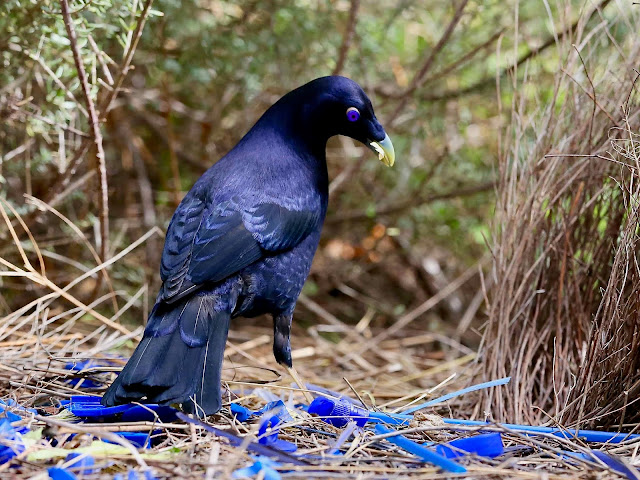In May 2016,
I featured a post on Satin Bowerbirds. Back then, these birds had maintained active
bowers, one at a time, in our garden for over ten years – you can see the post
here: http://avithera.blogspot.com/2016/05/satin-bowerbirds.html
Now, over
two years on, we still have an active bower. The bower is moved every year or
two to a new location in the garden. Over twelve years or more, we have had several new mature
male Satin Bowerbirds responsible for the new bowers though I am sure
individual males have maintained bowers for at least two or three years before
a new male has taken over.
Even though
the males build bowers in our garden where they must tolerate our presence,
they remain very wary of our approach and will not stay at the bower if we come
too close. So a hide must be used at the bower for close observation and photos.
Given they usually select well-hidden locations for their bowers, obtaining
photos is difficult and often impossible. Over the years only a few of the many
bower locations within our garden have allowed a hide to be set up with
reasonable views of the bower and the display area within a suitable distance,
with good light and minimal disturbance.
The current
bower was moved from its previous location over several weeks back in autumn. By
chance the new bower location presented an opportunity, with the judicious use
of a few pieces of string, to use my chair-hide and a 300mm focal length lens
to observe the activity at the bower and obtain photos.
As the 2018-19
breeding season approaches (September – February) the mature male is busy attending
to the bower and display area. He spends his time at the bower adding and
adjusting sticks to the bower and arranging his precious blue objects along
with a much smaller number of yellow objects and flowers.
Please click on photos
to enlarge.
 |
| Our resident Satin Bowerbird adding a stick to his bower. |
The number of blue objects has grown over the years and now easily exceeds sixty items. Most of the objects from the old bower were moved to the new bower. In addition, new items are added although items are also lost to theft by other competing males.
 |
| Photo date 22/08/18 - the objects are constantly being shuffled about the display area both by the male and visiting females who also pick them up and move them about. |
 |
| Photo date 2/09/18 - eleven days later and the arrangement of objects has completely changed. |
 |
| A few yellow objects are included among the blue items. Small yellow Correa reflexa flowers are popular at present – these flowers have come from beyond our garden. |
Picking the juvenile males from the females is difficult as they look very similar. Based on the behaviour of the mature male at the bower I now think it is safe to assume that any of the birds accepted at the bower at this time of year and that elicit encouraging displays from the mature male, are female. Other female looking birds I see chased off in a very rapid and aggressive manner I am assuming are unwelcome juvenile males – they never stay long enough for photos or visual ID.
The following
four photos are of a female at the bower.
The remaining
photos are of the mature male owner of the bower and display arena.
 |
| The male in normal pose with feathers held close to body. |
 |
| The male is fastidious with bower and arena maintenance. |
In the following
two photos, the male is holding small yellow flowers in his bill.
He
sometimes holds multiple objects, both blue and yellow in his bill to impress
the females.
 |
| Here he is holding a leaf, a small yellow flower and a blue plastic milk bottle top in his bill – a female, not visible in the photo, is standing in the bower. |
 |
| A final photo of the male in normal pose again. |
I hope to bring you more photos of the male and females at the bower over the coming breeding season and with luck and patience, to capture some of the display action.
You can
read an excellent brief overview description of the fascinating bowerbirds
here:
You may
also like to see the Western Bowerbird photographed at the Olive Pink Gardens
in Alice Springs here: http://avithera.blogspot.com/2015/07/olive-pink-botanic-gardens-alice-springs.html











No comments:
Post a Comment